Wilvo V40 test drive since 2012
Oxygen mask
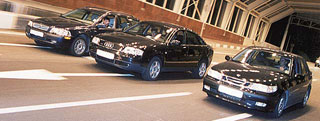 When the wind walks in pockets, this is bad. When your car is good in the engine. Especially if it is Volvo V40, Saab 9-5 Aero or A6 2.7 Quattro.
When the wind walks in pockets, this is bad. When your car is good in the engine. Especially if it is Volvo V40, Saab 9-5 Aero or A6 2.7 Quattro. In customs, the multi-liter engine is primarily associated with such a kalym that you somehow do not want to marry a powerful car.
At the time of a woeful study of the Customs Code, the idea of \u200b\u200ba hadwell car comes. Many automakers have long learned to significantly increase the engine power without increasing its working
 volume. Tuning ateliers and sports garages also use boosts to achieve their ambitious goals. The people call such cars turbocharged, although this is not entirely true - engines are inflated not only by turbochargers, but also by mechanical superchargers. The principle is simple: by pumping more air into the receiving manifold, the amount of fuel can be increased - accordingly, the power increases.
volume. Tuning ateliers and sports garages also use boosts to achieve their ambitious goals. The people call such cars turbocharged, although this is not entirely true - engines are inflated not only by turbochargers, but also by mechanical superchargers. The principle is simple: by pumping more air into the receiving manifold, the amount of fuel can be increased - accordingly, the power increases. The latter are devices with a mechanical drive of the rotor from the crankshaft and have been widely used from about the 30s of the last century. In these superchargers, air compression and its supply to the intake manifold occur mechanically - by reducing the volume of the cavity between the working surfaces of the rotor.
 In turbochargers, the work of the turbine does not depend directly on the frequency of rotation of the crankshaft - there is no mechanical connection between them. In such devices, part of the exhaust gas energy is used to rotate it.
In turbochargers, the work of the turbine does not depend directly on the frequency of rotation of the crankshaft - there is no mechanical connection between them. In such devices, part of the exhaust gas energy is used to rotate it. Mechanical superchargers have one serious drawback - part of the engine power is selected on them, which inevitably leads to a decrease in the efficiency. But cars with such engines are much more sensitive to the accelerator pedal. The efficiency of turbochargers is much higher, but they also have a serious drawback - they have less acceptance. But they have already learned to fight this, and the aggressiveness of turbochargers is growing steadily.
Many manufacturers use intermediate air cooling in high -pressure turbines. This is not necessary, but desirable. When compressed, the air heats up - therefore, its density decreases. This means that oxygen, so necessary for combustion of the mixture, enters the cylinders much less. And if the air is cooled, then these losses can be partially avoided.
 The cost of turbocharged cars is higher than simple, atmospheric. This is due to the fact that their engines are a more complex design and, primitively, more metal has gone to manufacture.
The cost of turbocharged cars is higher than simple, atmospheric. This is due to the fact that their engines are a more complex design and, primitively, more metal has gone to manufacture. A turbocharged car should be treated carefully, as its engine works in a more aggressive environment. The thermal load on all parts increases significantly, especially for the piston group. Therefore, it is not necessary to drive constantly on turbocharged cars - this leads to the rapid wear of components and mechanisms. It is also not recommended to turn off the engine at the same second when the speedometer arrow fell to zero. In a cloak of any type, the rotor continues its crazy rotation for some time, and if the engine is turned off, oil ceases to flow into it, and he ends his work as dry. We hope not to explain what it is fraught with.
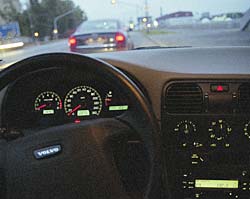 BREEZE. For all Volvo series 40 of the second generation, modernized five -cylinder engines are installed. There are ordinary, atmospheric, and there is also a mechanical turbine of low pressure - about 0.4 bar. For reference: an ordinary, atmospheric engine of the same volume develops a power of 136 hp, which is 29 less than Low Pressure Turbo. The winnings in power guarantees the owner of a turbocharged car extra 2 seconds. When starting from a place and an increase of 25 km to maximum speed.
BREEZE. For all Volvo series 40 of the second generation, modernized five -cylinder engines are installed. There are ordinary, atmospheric, and there is also a mechanical turbine of low pressure - about 0.4 bar. For reference: an ordinary, atmospheric engine of the same volume develops a power of 136 hp, which is 29 less than Low Pressure Turbo. The winnings in power guarantees the owner of a turbocharged car extra 2 seconds. When starting from a place and an increase of 25 km to maximum speed. The Swedes position this car as a family station wagon with a pronounced sports character. I don’t know how about the family, but the V40 has more than enough. He reaches the peak of his torque a little later than other cars participating in the test, but still much earlier than a simple atmospheric engine. What does this mean in practice?
Volvo V40 is the only car in our company with a mechanical box. With active work with the first and second gears, it really allows you to shoot at a traffic light or easy to go to risky overtaking on the highway on a lowered one. Which was very pleased - with a sharp start from a place or when accelerating in reduced gear, we could not find the effect of turboyama.
During our photographic vigils in Moscow at night, I constantly mowed my eyes on the display of the on -board computer, put up for the average fuel consumption and zeroled before the start. So, no matter how I tried, the average fuel consumption stubbornly kept in the limit of 9.3-9.8 l/100 km. Excellent indicators for a turbocharged car with a 2.0 liter engine. This is what a low -pressure turbine means - it provides at the same time a wonderful selection of low revolutions and a good fuel economy. By the way, on the atmospheric motor, the average fuel consumption indicator according to the principle of the city/village is not much different from a turbocharged - 8.3 liters per 100 km. So the car is really family - the budget will not undermine. And the price is quite attractive.
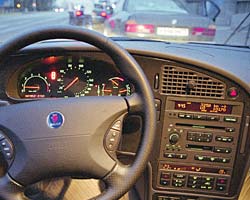 STORM. Unlike Volvo, another boost scheme was used to SAAB. Aero has a high -pressure turbine with an intermediate cooler of pumped air. Despite the fact that the degree of compression is slightly higher than on Volvo-9.3 versus 9.0-the extra three hundred grams in the volume of the motor nullify all the owner’s dreams about fuel saving-Saab 9-5 accepts more to the chest 13 liters of gasoline in the city. Naturally, our calculations were not conducted using special devices, but according to the testimony of the on -board computer. The ability to compare these and other indicators with a simple, atmospheric engine did not have the same volume-there are no such in the line 9-5.
STORM. Unlike Volvo, another boost scheme was used to SAAB. Aero has a high -pressure turbine with an intermediate cooler of pumped air. Despite the fact that the degree of compression is slightly higher than on Volvo-9.3 versus 9.0-the extra three hundred grams in the volume of the motor nullify all the owner’s dreams about fuel saving-Saab 9-5 accepts more to the chest 13 liters of gasoline in the city. Naturally, our calculations were not conducted using special devices, but according to the testimony of the on -board computer. The ability to compare these and other indicators with a simple, atmospheric engine did not have the same volume-there are no such in the line 9-5. But when you go to the Saab 9-5 Aero, there is no time to peer into the display-all the attention must be given to the road. On a test car with a 4-speed automatic, the effect of turboyama was quite clearly traced. But he literally occupied a fraction of a second and was partly manifested because we expected this. Maybe the fault of this is not a bent, but an automatic gearbox, which is also characterized by some thoughtfulness.
In fairness, we note that the slowdown in the reaction of the car to the gas pedal takes a negligible time - about the same as the thought rushes in the head now!. And Saab really tears! The term acceleration in relation to Aero is more correct to replace with a jerk. The Overboost mode is included. If you sharply drown the pedal into the floor, then the pressure pressure is rapidly increasing and holds for five to ten seconds. In these moments, a rapid set of speed occurs. Then the engine speeds and the pressure in the turbine begin to fall, and the acceleration slows down a bit. If you switch the automatic transmission to the SPORT position, then the sensations are made even sharper.
Saab is the only model where the turbocharged sensor is located on the dashboard. It is very interesting to track the Overboost mode - as a pointer of the pressure of the pumped air instantly flies into the red zone and hangs there for a few seconds. This device looks rather funny, but it is not clear its practical application - we repeat: at such a moment it is better to look not at the devices, but at the road.
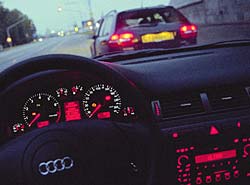 SQUALL. Audi has already become famous for the fact that the engines here are not just turbocharged, but Biturbo. Yes, and V6. Actually, due to the location of the cylinders in Ingolstadt, they decided to install two light and compact turbines instead of one-each blowing in its own series of cylinders. This layout made it possible to get rid of the main shortcomings of turbocharged - a brake reaction to gas and excessive gluttony. This is achieved through the use of variable phases of gas distribution and the intellectual electronic system for control of injection and contraining pressure regulation. Naturally, due to the lower compression (9.3 versus 10.6), the boost of the motor consumes more fuel, but the liter does not play a decisive role - in this case.
SQUALL. Audi has already become famous for the fact that the engines here are not just turbocharged, but Biturbo. Yes, and V6. Actually, due to the location of the cylinders in Ingolstadt, they decided to install two light and compact turbines instead of one-each blowing in its own series of cylinders. This layout made it possible to get rid of the main shortcomings of turbocharged - a brake reaction to gas and excessive gluttony. This is achieved through the use of variable phases of gas distribution and the intellectual electronic system for control of injection and contraining pressure regulation. Naturally, due to the lower compression (9.3 versus 10.6), the boost of the motor consumes more fuel, but the liter does not play a decisive role - in this case. For reference: close in volume of a 2.8 liter engine develops a power of 193 hp. Against 230 on Burbo. The fuel consumption is 15.4 liters on an atmospheric engine, and 16.6 on a turbocharged. The maximum speed of two cars is 225 and 240 km/h, respectively.
Acceleration on the Audi A6 is powerful and even - this is not a sports style of hot Swedish guys - Volvo and Saab. Not the slightest hint of failures and a slow reaction to the gas pedal. Everything happens according to the principle of how I pressed - so I went. The turbine is included in the engine already at 1700 rpm, and the engine is rapidly starting to go to maximum torque. Full -wheel drive with Torsen differential has its positive effect on the smoothness of the course and acceleration.
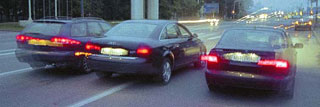 All this is wonderful, but there is one but. The Biturbo accelerated dynamics is no different from acceleration A6 with atmospheric engine 2.8 and is 8.3 seconds. up to 100 km/h. Therefore, we have a logical question: why pay extra money for two parallel turbines and cooler? The difference in price is about $ 10-12 thousand in favor of the atmospheric engine. It turns out that, by purchasing a fonding engine, the buyer pays only one significant advantage - the maximum speed does not count. Due to the increased power and features to maintain the maximum torque in the intervals of 1700-4600 Audi Biturbo engine speeds are much more harsh from the move, for example, in the range of 60-100 km/h. Making sharp overtaking and rebuilding on it is definitely easier. But here a counter question arises: how solid is the owner of a car of such a class to rush along the roadway, like a flush on glass? However, this is a completely different story.
All this is wonderful, but there is one but. The Biturbo accelerated dynamics is no different from acceleration A6 with atmospheric engine 2.8 and is 8.3 seconds. up to 100 km/h. Therefore, we have a logical question: why pay extra money for two parallel turbines and cooler? The difference in price is about $ 10-12 thousand in favor of the atmospheric engine. It turns out that, by purchasing a fonding engine, the buyer pays only one significant advantage - the maximum speed does not count. Due to the increased power and features to maintain the maximum torque in the intervals of 1700-4600 Audi Biturbo engine speeds are much more harsh from the move, for example, in the range of 60-100 km/h. Making sharp overtaking and rebuilding on it is definitely easier. But here a counter question arises: how solid is the owner of a car of such a class to rush along the roadway, like a flush on glass? However, this is a completely different story. Text Nikolay Kachurin, photo Alexey Ilyin
Source: "Autopilot"

.jpg)
.jpg)
.jpg)
.jpg)
.jpg)



